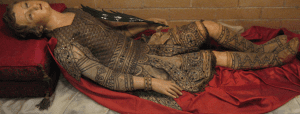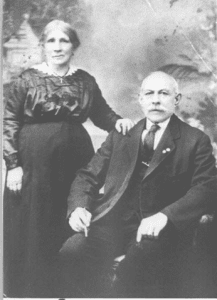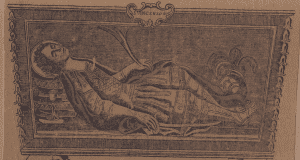After the completion of the 112th Feast of San Vincenzo in New York City the story of how the statue at St. Joseph’s Church was made surfaced. This story ends speculation about the origins of the statue and perhaps provides insight into how the banner from the Societá San Vincenzo Martire di Craco was made.
Rosa D’Elia Francavilla shared a story about her great grandfather Pasquale Marrese making the clothing for the statue. Rosa’s mother, Maria Teresa Tuzio was the daughter of Giuseppe Tuzio and Rosa Marrese who were married in Craco in 1902. Rosa Marrese’s father, Pasquale Marrese (Born 1846 Craco, died 1914 Jersey City, NJ) had emigrated to the US in the 1880s was a mainstay of the Crachesi community in New York City. Pasquale brought his tailoring skills to America and established a shop at 53 Spring St., Manhattan. He also encountered both tragedy and also success as one of the founders of the Societá San Vincenzo Martire di Craco an organization he helped create to aid his paesani immigrants. As an incorporator and Director of the Societá in 1899 he set a course for the organization that would support the Cracotan community in New York for the next 50 years.
By 1899, he had moved his household from 221 Mulberry St. to Jersey City, NJ but continued to maintain his tailor shop in New York. In 1901 when the Societá San Vincenzo Martire di Craco entered into a contract with St. Joachim’s Church to provide a statue of San Vincenzo and a relic of the saint, considerable coordination and work was required. This may explain why it took two years from the organization’s founding to arrange to install the statue and relic in the church. Pasquale Marrese’s role becomes even more important as we learn from his great-granddaughter that he was responsible for sewing the clothing on the statue in New York. It makes great sense that a Crachese, with tailoring skills would be involved in creating the statue of San Vincenzo in New York in 1900. Relying on his memory of the statue’s clothing in Craco and perhaps the woodcut of the saint that was brought to America by the immigrants he lovingly fabricated the statue’s intricate and bejeweled clothing. More than likely he also created the statue’s body using a mannequin. With the extensive detail some of the work was also done by fellow Cracotans who were employed at his shop.
il Sarto di San Vincenzo
Al termine della 112esima festa di San Vincenzo nella città di New York, è emersa la storia di come la sua statua risucì ad arrivare nella chiesa di St Joseph. Questo racconto pone fine alle varie speculazioni sulle origini della statua, fornendo una traccia informativa importante anche sulla creazione del manifesto della Societá San Vincenzo Martire di Craco.
Rosa D’Elia Francavilla ha iniziato a spiegare la storia di come suo nonno, Pasquale Marrese, ha filato il tessuto per la statua. La madre di Rosa, Maria Teresa Tuzio, era la figlia dei coniugi Giuseppe Tuzio e Rosa Marrese, uniti in matrimonio a Craco nel 1902. Il padre di Rosa Marrese, Pasquale Marrese (nato nel 1846 a Craco e morto nel 1914 a Jersey City, nello stato del New Jersey) emigrò negli Stati Uniti nei tardi anni ottanta del diciannovesimo secolo: durante la sua vita avrebbe rappresentato un pilastro importante della comunità crachese di New York City.
Pasquale riuscì a replicare le proprie abilità sartoriali in America, creando una sua bottega su Spring Street 53 a Manhattan. Attraversò diversi momenti tragici ma anche di successo come fondatore della Societá San Vincenzo Martire di Craco, organizzazione che lui aiutò a formare per aiutare e dare supporto agli altri paesani immigrati. Come fondatore e direttore della Societá, nel 1899 delineò una struttura organizzativa che avrebbe garantito un sostegno alla comunità crachese di New Yok per i 50 anni successivi.
Nel 1899 traslocò nella sua nuova dimora di Mulberry Street 221 a Jersey City, stato del New Jersey, mantenendo però il suo negozio a New York. Nel 1901, quando la Societá San Vincenzo Martire di Craco firmò un contatto con la chiesa di St. Joachim per dare in custodia la statua di San Vincenzo e la sua reliquia, fu necessaria una buona dose di lavoro e coordinazione. Questo spiega in parte il motivo per cui furono necessari ben due anni per l’organizzazione prima di riuscire a trovare una sede definita per installare la statua e la reliquia.
Il ruolo di Pasquale Marrese diventa sempre piu’ fondamentale se pensiamo a quello che ci ha riferito la sua pro-pronipote, quindi la responsabilità che ebbe nella cucitura del tessuto della statua del santo a New York. Ha senso pensare che fosse proprio un crachese con delle abilità sartoriali ad essere stato incluso nella creazione degli indumenti della statua di San Vincenzo di New York nel 1900. Pasquale creò la tela, ingioiellata e ricca di intricati particolari, volendo esprimere tutta la sua devozione: nella fabbricazione si basò probabilmente su quelli che erano i suoi ricordi dell’immagine delle vesti della statua a Craco e forse anche sull’incisione in legno della statua stessa. Con grande probabilità sfruttò un manichino


